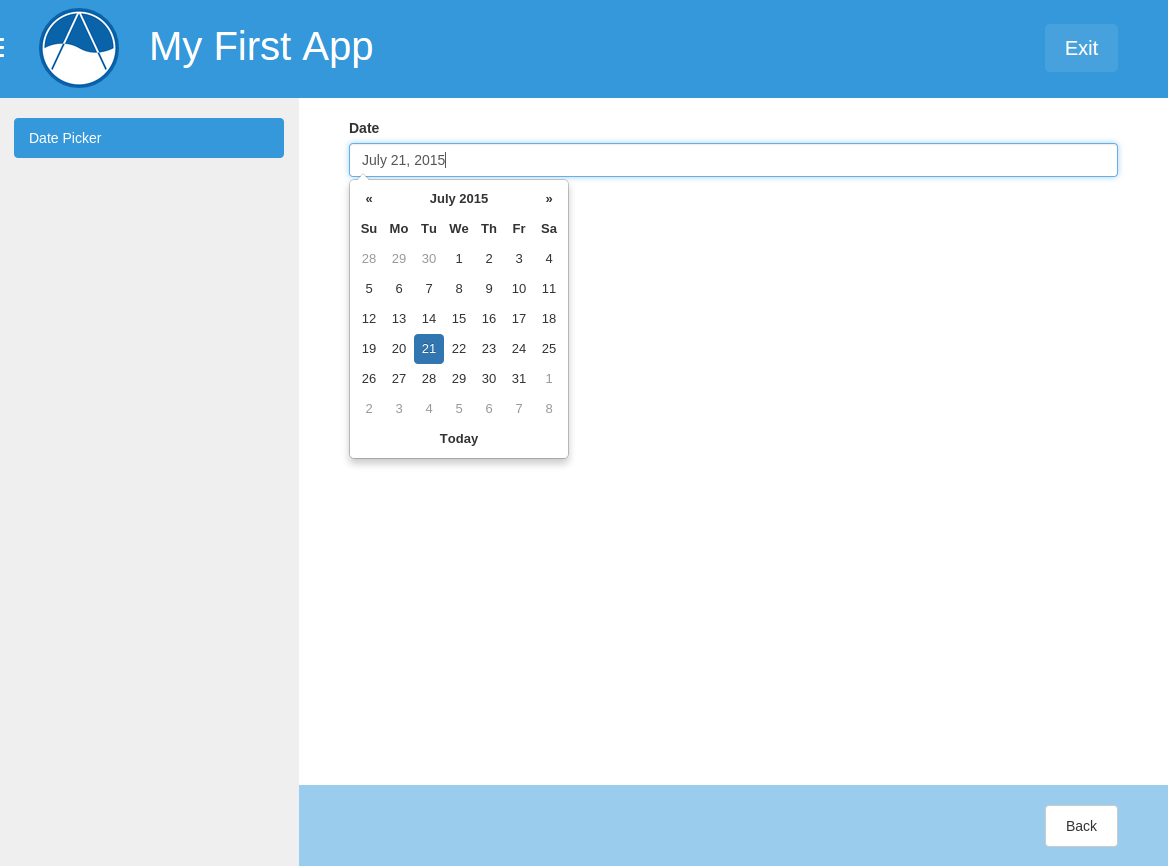Template Gizmos API
Last Updated: March 2022
Template Gizmos are building blocks that can be used to create beautiful interactive controls for web apps. Using the Template Gizmos API, developers can add date-pickers, plots, and maps to their app pages with minimal coding. This article provides an overview of how to use Gizmos.
For a detailed explanation and code examples of each Gizmo, see the Gizmos Options Objects section.
Working with Gizmos
The best way to illustrate how to use Template Gizmos is to look at an example. The following example illustrates how to add a date picker to a page using the DatePicker Gizmo. The basic workflow involves three steps:
Define gizmo options object in the controller for the template
Load gizmo library in the template
Insert the gizmo tag in the template at the desired location
A detailed description of each step follows.
1. Define Gizmo Options Object in Controller
The first step is to import the appropriate options object and configure the Gizmo. This is performed in the controller of the template where the Gizmo will be used.
In this case, we import DatePicker and initialize a new object called date_picker with the desired options. Then we pass the object to the template via the context dictionary:
from tethys_sdk.gizmos import DatePicker
def gizmo_controller(request):
"""
Example of a controller that defines options for a Template Gizmo.
"""
date_picker = DatePicker(
name='date',
display_text='Date',
autoclose=True,
format='MM d, yyyy',
start_date='2/15/2014',
start_view='decade',
today_button=True,
initial='February 15, 2017'
)
context = {'date_picker': date_picker}
return render(request, 'my_first_app/template.html', context)
The Gizmos Options Objects section provides detailed descriptions of each Gizmo option object, valid parameters, and examples of how to use them.
2. Load Gizmo Library in Template
Now near the top of the template where the Gizmo will be inserted, load the tethys_gizmos library using the Django load tag. This only needs to be done once per template:
{% load tethys_gizmos %}
4. Insert the Gizmo
The gizmo tag is used to insert the date picker anywhere in the template. The gizmo tag accepts a Gizmo object of configuration options for the Gizmo:
{% gizmo <options> %}
For this example, call the gizmo tag with the date_picker object that was defined in the controller and passed to the template as an argument:
{% gizmo date_picker %}
Rendered Gizmo
The Gizmo tag is replaced with the appropriate HTML, JavaScript, and CSS that is needed to render the Gizmo. In the example, the date picker is inserted at the location of the gizmo tag. The template with the rendered date picker would look something like this:

Gizmo Showcase App
The Gizmo Showcase App provides live demos and code examples of every Tethys Gizmo. See Gizmo Showcase App to learn how to install the Gizmo Showcase app. For explanations of the Gizmo Options objects and code examples, refer to the Gizmos Options Objects section.
API Documentation
This section contains a brief explanation of the template tags that power Gizmos. These are provided by the tethys_gizmos library that you load at the top of templates that use Gizmos.
gizmo
Inserts a Gizmo at the location of the tag.
Parameters:
options (dict) - The configuration options for the Gizmo. The options are Gizmo specific. See the Gizmo Showcase documentation for descriptions of the options that are available.
Example:
{% gizmo date_picker %}
import_gizmo_dependency
Tells the gizmo_dependencies to load in the dependencies for the gizmo. This tag must be in the import_gizmos block. This is useful for pre-loading the dependencies of a gizmo that is not loaded on the initial page load (e.g.: loading the gizmos using AJAX after the initial page load).
Parameters:
name (string or literal) - The name of the Gizmo for which to load dependencies as a string (e.g.: "date_picker") or a literal (e.g.: date_picker).
Note
You can get the name of the gizmo through the gizmo_name attribute of the gizmo object.
Controller Example:
from tethys_sdk.gizmos import DatePicker
def example_controller(request):
"""
Example of a controller that defines options for a Template Gizmo.
"""
context = {'date_picker_name': DatePicker.gizmo_name}
return render(request, 'path/to/my/template.html', context)
Template Example:
{% block import_gizmos %}
{% import_gizmo_dependency date_picker_name %}
{% endblock %}
gizmo_dependencies
Inserts of the CSS and JavaScript dependencies at the location of the tag for all gizmos loaded in the template with the gizmo tag. This tag must appear after all occurrences of the gizmo tag. In Tethys Apps, these depenencies are imported for you, so this tag is not required. For external Django projects that use the tethys_gizmos Django app, this tag is required.
Parameters:
type (string or literal, optional) - The type of dependency to import. This parameter can be used to include the CSS and JavaScript dependencies at different locations in the template. Valid values include "css" for CSS dependencies, "global_css" for CSS library dependencies, "js" for JavaScript dependencies, and "global_js" for JavaScript library dependencies.
Examples:
# No type parameter
{% gizmo_dependencies %}
# CSS only
{% gizmo_dependencies global_css %}
{% gizmo_dependencies css %}
# JavaScript only
{% gizmo_dependencies global_js %}
{% gizmo_dependencies js %}
Gizmos Options Objects
This section provides explanations of each of the Gizmo Options Objects available for configuring Gizmos. It also provides code and usage examples for each object.